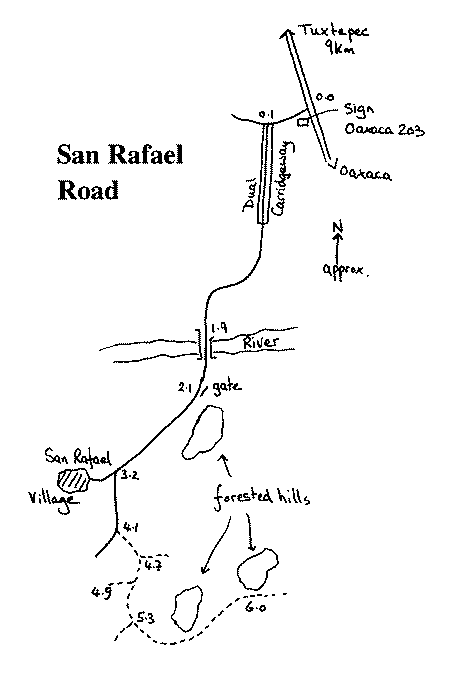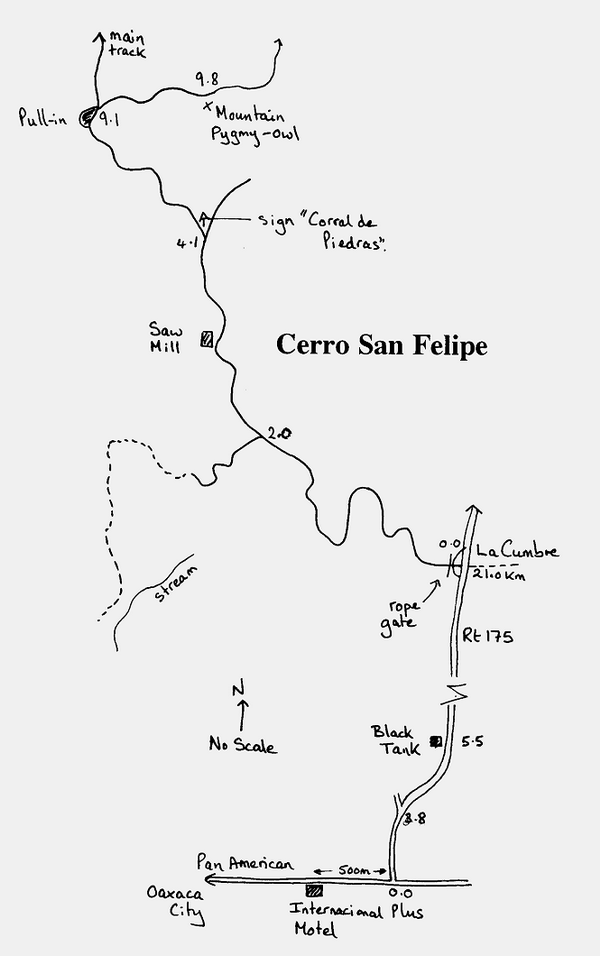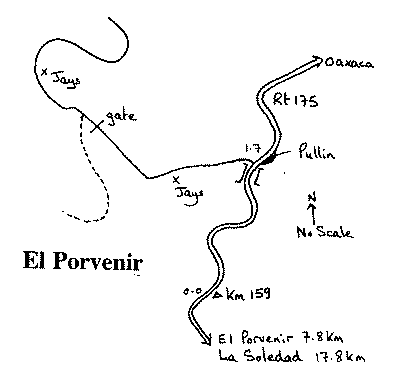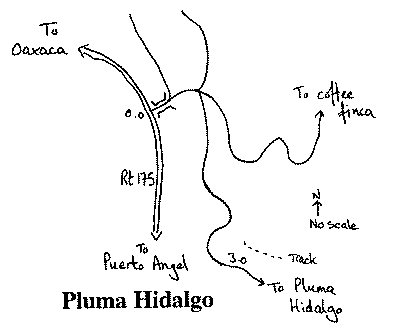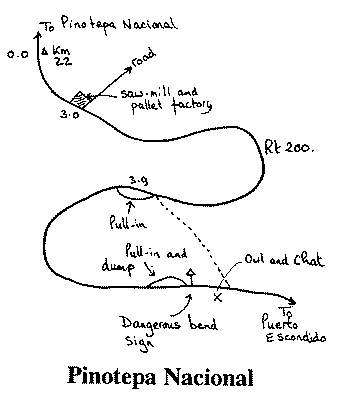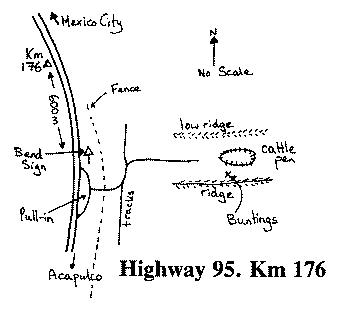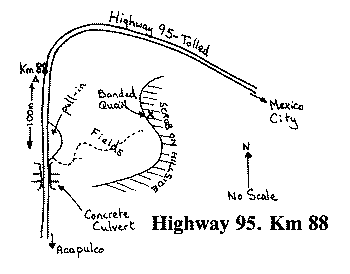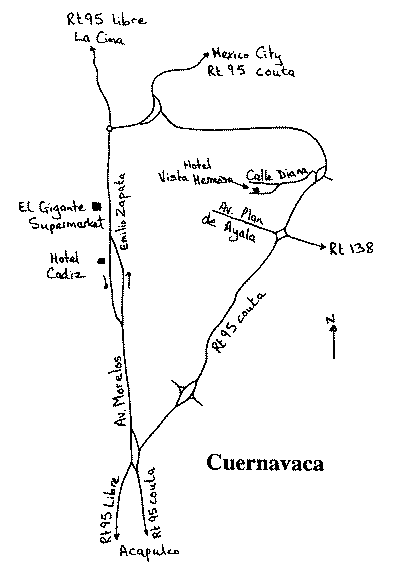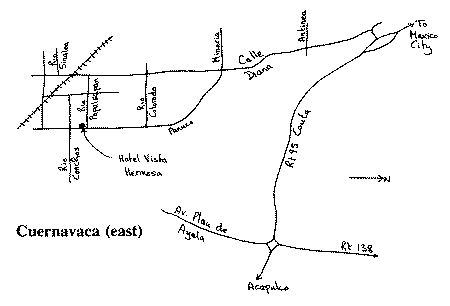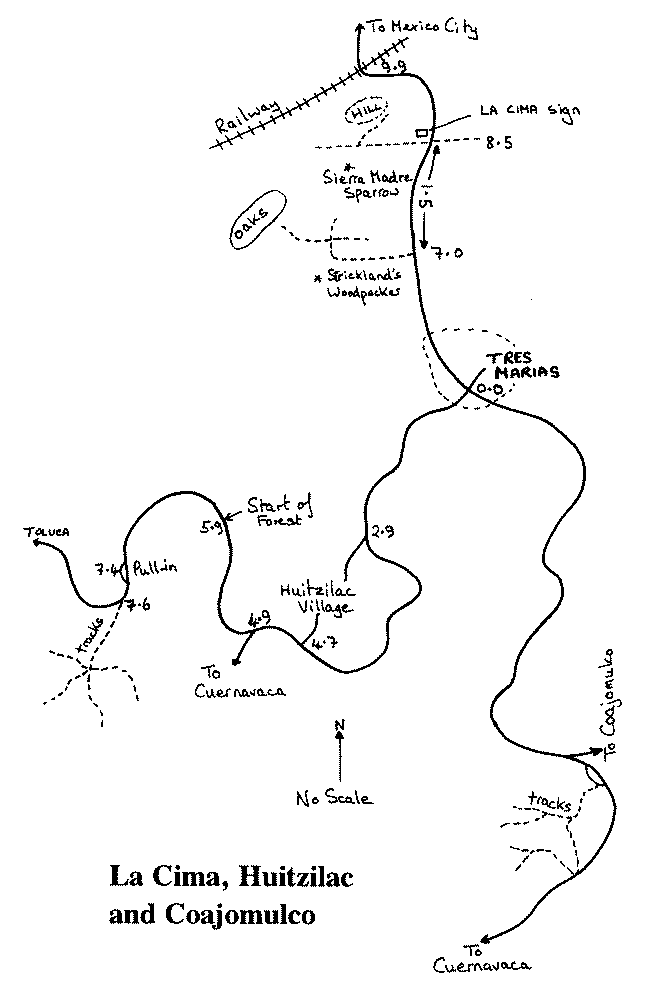Section 1 - Introduction, logistics, itinerary and general information.
Section 2 - Birding sites (Nuevo León to Veracruz).
Section 3 - Birding sites (Oaxaca to Coahuila).
Section 4 - Annotated checklist.
Section 5 - Other references and bibliography.
Site M6. San Rafael Road, Oaxaca.
We accidentally discovered this area of fields interspersed with forested rocky hills while trying to navigate into some private property seen from the road. Birding was slow due to the intense heat in the middle of the day, but should be excellent on the forested hills early in the morning. We had Little Tinamou (heard), Rufous-breasted Spinetail, Grey-headed Dove, Ferruginous Pygmy-Owl and other birds. Take Rt. 175, the Oaxaca road, out of Tuxtepec. About 9 km beyond Tuxtepec, just after passing the Fapatux wood-mill and crossing a railway crossing, turn right on the San Rafael Road. (An adjacent sign says "Oaxaca 203 km").
|
Zero the oedometer here. After 0.1 km, turn left on a disused dual highway, and continue beyond a bridge over a river at 1.9 km. Forested, limestone outcrops can be explored throughout the area, so just follow your nose. The map shows the tracks we explored. Species recorded at San Rafael Road: Little Tinamou 3h |
Site M7. Oaxaca City and Monte Alban Ruins
Scrub, at 1,850 metres, on the slopes below the famous ruins at Monte Alban (a few km west of Oaxaca City), holds many species of interest. These include the endemic Ocellated Thrasher, Slaty Vireo, Dwarf Vireo (rare), and Pileated Flycatcher. Use the city map to find your way westward out of the city toward Monte Alban, which opens to tourists at 08h00. It is easy to explore the scrub downslope before the tourists arrive. The most productive scrub we found was along the long, northern edge of the ruins, with that higher-up, nearer the ruins, better than that downslope.
Species recorded at Monte Alban:
Turkey Vulture 2 |
Slaty Vireo 1 |
Site M8. Cerro San Felipe
Cerro San Felipe is a still relatively forested mountain about 20 km north of Oaxaca City. Habitat is an oak-pine mix, which extends to over 3,000 metres altitude. In Oaxaca City, find the Pan American Highway (Rt. 190) which runs across the northern edge of the city. Follow it eastward out of the city and at the junction with Rt. 175, turn left (north) toward Tuxtepec and Ciudad Alemán. Zero the oedometer at this junction. At 5.5 km, on the west side of the road, there is an large, black, oil tank, evidently abandoned for some time. Pull in, and explore the scrub on the opposite side of the road. This is a good spot for Oaxaca Sparrow and Slaty Vireo. Bridled Sparrow is also supposed to occur, but we failed to find any. At 21 km, on the brow of a hill, you will arrive at the village of La Cumbre, where a track goes off to the left (northwest) toward Cerro San Felipe. Guards may bar access to the road to Cerro San Felipe at La Cumbre during the day, although there should be no problem entering early in the morning or in late afternoon, and once past the entrance, you can stay as long as you like. Two guards were at the entrance when we came down the mountain in mid-afternoon, but on all other occasions, we found the entrance unguarded. Jeff Glassberg reports that he was barred from entering by four guards in March 1993. There is sometimes a metal cable across the track, which may be padlocked. If it is, a man who lives in a house to the left of the entrance has a key and will open for you.
|
|
Re-zero the oedometer at the start of this track. We had Long-tailed Wood-Partridge crossing the road in open scrub about 1.5 km from the turnoff. At 2.0 km, a very rough track, which we walked, goes off to the left. Dwarf Jay has been seen along there. Continuing further up the hill, you will pass a sawmill and arrive at a major fork (with possibly a sign reading "Corral de Piedras" and showing two hands holding a deer) at 4.1 km, at which you should keep left. At 9.1 km, the track forks again, and there is a large pull-in on the left. All habitat in this area is worth exploring, and we spent most of our time there. We had Mountain Pygmy-Owl about 700 metres along the last right hand-fork.
Species recorded at Cerro San Felipe:
Turkey Vulture 1 |
Brown Creeper 1 |
Site M9. El Porvenir, Oaxaca
|
This very degraded remnant of forest was one of the first acceptable looking pieces of habitat we encountered travelling south from Oaxaca on Rt. 175 toward Puerto Ángel and the Pacific coast. It was here that we discovered White throated Jay, apparently the first record away from Guerrero for many years. The nearest village is El Porvenir (not marked on Pemex). A driveable track turns off on the western side of Rt. 175, 1.5 km north of the 159 kilometre post. Just before the track, there is a small bridge and a pull-off on the east side of the road. This wide track, which had recently been upgraded (presumably for logging far up-slope), follows a stream through cut over forest. We saw one pair of Jays less than 100 metres along the track, and another pair a further 300 metres along. Two hundred metres from the road, a gate blocks the track, and there is a "no hunting" sign. We camped along the track and saw no one while there. Other than Western Whip-poor-will and Mottled Owl, no night birds were seen, though presumably the area holds more. The first 600 metres of the main track seemed to be the most productive. |
Species recorded at El Porvenir:
Red-tailed Hawk 1 |
Grey-breasted Wood-Wren 3 |
Site M10. Pluma Hidalgo, Oaxaca
This is a well-known birding site, and well worth at least a full day, probably longer. The two hours we spent were completely inadequate. Nevertheless, we saw several species of note. Camping here is highly recommended, with the distinct possibility of Eared Poorwill and other night birds. Alternatively there are several reasonable-looking hotels in San Pedro Pochutla on Rt. 175, just before Puerto Ángel. The habitat is predominantly coffee shade forest, with some abandoned areas of dense secondary growth. Judging by call, White fronted Quail-Dove is abundant. Pluma Hidalgo, marked on the Pemex road atlas about 25 km north of Puerto Ángel, is accessed via two gravel roads branching eastward off the main Rt. 175. Note that the Pemex road atlas only shows the more southerly route, passing through Toltepec.
|
The more northerly one, well sign posted to Pluma Hidalgo, branches off 49.6 km north of the main Rt. 175/Rt. 200 intersection at Puerto Ángel. On turning off the main road you are met with a maze of roads. The Pluma Hidalgo road is the first right going downhill. We first took the wrong turn and birded in a coffee finca, where a Blue-crowned Hummingbird was seen. We birded a one kilometre section between 4.2 and 5.2 km along the track to Pluma Hidalgo after turning off the main road. Although the sides are steep, while hacking-up one slope to try for the quail-dove, we discovered a wide footpath winding through the shade forest, which presumably exited somewhere on the road, and made a superb birding trail. Unfortunately we had insufficient time to follow it. The habitat continued all along the road to Pluma Hidalgo, as far as we could see. |
Species recorded at Pluma Hidalgo:
Turkey Vulture 1 |
Golden Vireo 2 |
Site M11. Pinotepa Nacional, Oaxaca
We worked several areas near Pinotepa Nacional. We had no specific stake-outs for any of the species of interest, so we merely jumped out of the car and birded in any suitable looking habitat. The following three areas along Rt. 200 were found to be quite productive:
|
Area 1 - 26 km east of Pinotepa. This is dry, fairly dense scrub, which can only be worked from the road. We had Least Pygmy-Owl responding to squeaking during the day, and Red-breasted Chat came in to tape. Park in the pull-off, 3.9 km east of the 22 kilometre post. Either walk the road, or the short track 200 metres up-hill. We saw both the owl and chat in the scrub just uphill from the usual, roadside rubbish dump. Species of note recorded: Amazona sp. 7 |
Area 2. Kilometre post 228 - west of Pinotepa Nacional. A further area of dry, open forest is found along the road starting about 20 km west of Pinotepa Nacional. We stopped at a recently burned area next to the 228 kilometre post, where several sparrows were feeding on burnt seeds. A major find of the trip was several Yellow-headed Parrot in the area.
Species recorded:
Roadside Hawk 1 |
White-throated Magpie-Jay 10 |
Area 3. Kilometre post 233 - west of Pinotepa Nacional. Roadside scrub here was grazed by goats, but the bushes to the south of the road held Lesser Ground-Cuckoo and Black-chested Sparrow.
Site M12. Acapulco to Cuernavaca Highway 95
We stopped a few times along Highway 95, and had success in two areas - near kilometre posts 176 and 88. These distances presumably represent distances to Mexico City. Whenever possible we took tolled sections of the highway.
Area 1. About 176 km from Mexico City, and six hundred metres before kilometre marker 176, on highway 95 libre is a pull-in on the right (east) side. At the time, there was also a stall selling iced beer (but no other drinks) on the opposite side. We stopped in desert-like habitat with cardón cactus and, in the heat, walked about among some cattle and scrubby trees, where we found Orange-breasted Bunting. The altitude is 600 metres.
Area 2. Kilometre post 88. This is along one of the couta parts of Highway 95. We stopped the last hour or so before dark. Habitat was scrub and fields. A recently burnt area held the endemic Banded Quail. Altitude 1,000 metres.
|
|
Species recorded at Kilometre post 88:
Banded Quail 6+ |
Rufous-backed Thrush 2 |
|
Site M13. Saltillo, Coahuila Details of this reliable site for Worthen's Sparrow, were given in the MBA Newsletter Vol 1 No 87-3 (Sada 1987b). We arrived in the late afternoon and stayed only long enough to find the sparrow. From Saltillo, 83 km southwest of Monterrey, follow Rt. 54 south for about 40 kilometres. One hundred metres before kilometre post 308, a dirt track signposted "Tanque de Emergencía" goes off left (east). Zero the odometer. Following this track, you cross the railway line (about 1.8 km), pass to the left of the village (about 3 km), drive through a fenced area (6 km), and eventually encounter a large disused, concrete water tank (8 km). Worthen's Sparrow can be found anywhere in the area. We saw one immediately adjacent to the tank. |
Site M14. La Cima, Huitzilac and Coajomulco
This area of upland grassland and mixed forest is best worked by staying in Cuernavaca (see maps), about 50 km south of Mexico City. Birds and directions are covered in Wilson and Ceballos (1993). From Cuernavaca, drive northward on Rt. 95 libre for about 20 km to the small town of Tres Marias. Zero the odometer at the large (and only), crossroads junction in the middle of town. To get to La Cima, continue northward along the Rt. 95 for 8.5 km, where a track on the left (west) is possibly signed "La Cima". Park here and walk about in the bunch grass on the western side of the road. Without a tape, it may take a while to find the Sierra Madre Sparrow, as it is skulking, and much of the habitat has been plowed-up, thus reducing numbers.
|
Beware of the superficially similar Song Sparrow, which also occurs in the same grass. Strickland's Woodpecker can be found, with difficulty, in the tall pines 1.5 km back along the road to Tres Marias. For excellent, mixed oak-pine forest, return to Tres Marias, and turn west at the cross-roads, to Huitzilac. Follow the map, (in Huitzilac follow Toluca signs). At 5.9 km, the forest starts, with a pull-in on the right. The easiest access was via the series of tracks leading off downhill at 7.6 km. We also checked the tracks through the forest below the Coajomulco turn-off. We forgot to record the distance from Tres Marias, but the road junction is very obvious as you drive up the hill. This supposedly is the best area for White-striped Woodcreeper, though we failed to find it. |
|
|
Species recorded at La Cima (L), Huitzilac (H) and Coajomulco (C):
Band-tailed Pigeon 6 |
|
Section 1 - Introduction, logistics, itinerary and general information.
Section 2 - Birding sites (Nuevo León to Veracruz).
Section 3 - Birding sites (Oaxaca to Coahuila).
Section 4 - Annotated checklist.
Section 5 - Other references and bibliography.

